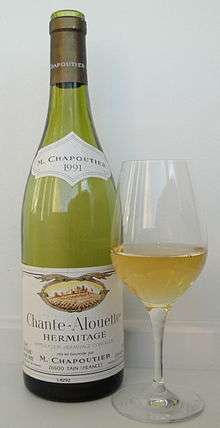Hermitage AOC
| Wine region | |
| Official name | Hermitage |
|---|---|
| Type | Appellation d'origine contrôlée |
| Country | France |
| Part of | Northern Rhone |
| Other regions in Northern Rhone | Crozes-Hermitage, Cornas, Côte-Rôtie |
| Climate region | continental climate |
| Size of planted vineyards | 345 acres (1.40 km2) |
| Grapes produced | Syrah, Marsanne, Roussanne |
Hermitage is a French wine Appellation d'Origine Contrôlée (AOC) in the northern Rhône wine region of France south of Lyon. It produces mostly red wine from the Syrah grape; however, small quantities of white wine are also produced from Roussane and Marsanne grapes. The hill is seen by some as the spiritual home of the Syrah grape variety.[1]
History
According to legend, the Knight Gaspard de Stérimberg returned home wounded in 1224 from the Albigensian Crusade and was given permission by the Queen of France to build a small refuge to recover in, where he remained living as a hermit (ermite in French). The chapel on top was built in honor of Saint Christopher and today is owned by the negociant Paul Jaboulet Âiné. Louis XIII made the wine a wine of the court after being offered a glass during a visit to the region in 1642. Louis XIV presented King Charles II of England with 200 casks of fine wine including examples from Hermitage, Champagne and Burgundy. The Romanovs also imported the wine. In the 19th century wines from Bordeaux were often "hermitaged" (hermitagé, that is, blended with Hermitage) and could fetch higher prices as a result. The appellation was established in its modern form in 1937.[2]
Geography
The appellation fans out from the town of Tain l'Hermitage. The vines grow on the south west side of a steep granite hill facing the afternoon sun and can be divided into a number of smaller vineyards. These are "Les Bessards" to the west, "L'Hermite and "La Chapelle on the top of the mountain, and "Bessards", "Le Méal", "Les Greffieux" and "Murets" to the east.[3] With 345 acres (1.40 km2) of vines, in soil composed greatly of granite and gravels, Hermitage produces 730,000 bottles of mostly red wines, annually.
Grape Varieties

Syrah is the primary red grape of Hermitage, mostly used on its own although the appellation rules do allow the addition of 15% or less of Marsanne and/or Roussanne grapes. Hermitage reds tend toward being very earthy, with aromas of leather, red berries, earth, and cocoa/coffee. Because of the high levels of tannin they are usually aged longer than American or Australian Syrahs and are often cellared up to 40 years.
Rich, dry white wines are also produced from a blend of Marsanne and Roussanne. These wines are also usually left to age, for up to 15 years. Vin de paille or Straw Wine is also produced in this region.
Sources
- Footnotes
- ↑ http://www.jancisrobinson.com/articles/the-hermitage-conundrum
- ↑ Niels Lillelund: Rhône-Vinene JP Bøger - JP/Politikens Forlagshus A/S, 2004. ISBN 87-567-7140-1, p. 84-86
- ↑ Niels Lillelund: Rhône-Vinene JP Bøger - JP/Politikens Forlagshus A/S, 2004. ISBN 87-567-7140-1, p. 86-88